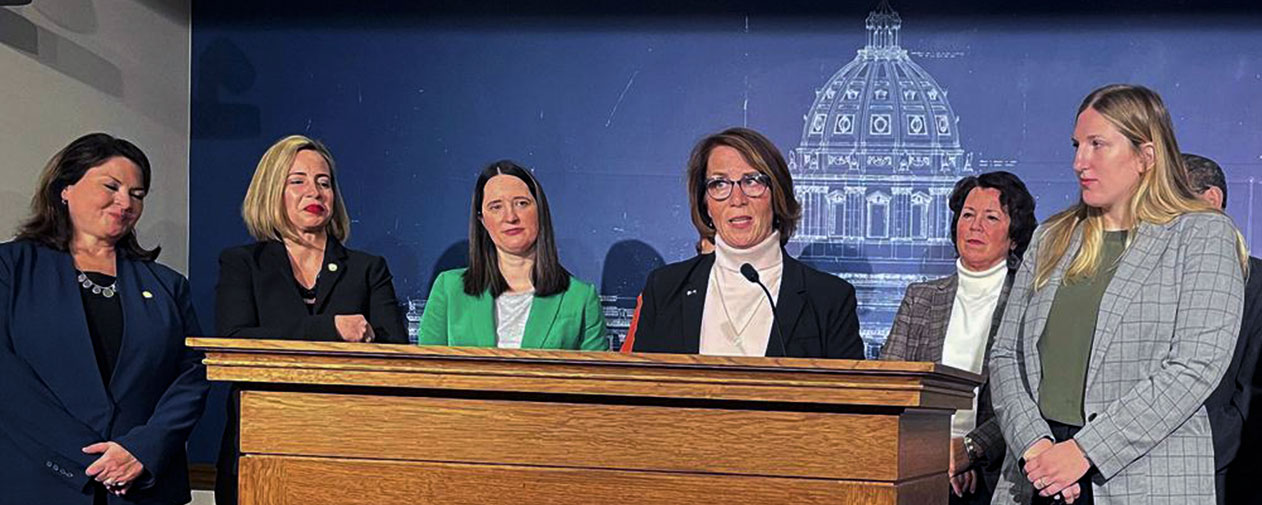
Defying the political history of the United States in which parties in power lose up and down the ballot at the conclusion of the first term of their president, Democrats ended Republican control of state legislative chambers across the country this week including in Michigan and Minnesota.
They also gained full control of state capitols in Maryland and Massachusetts, and in Wisconsin, they prevented the GOP from gaining a supermajority in the legislature there that would have rendered the newly-elected Democratic governor, Tony Evers, powerless. They retained full control in Illinois and New York.
Despite far better than expected Democratic totals nationally, control of the Congress is not yet determined. In the House, projections for Democrats range from 207 to 220 and for Republicans from 213 to 227. The number required for control is 218.
In the Senate races, Arizona and Nevada have yet to be called, and Georgia will go to a December 10 runoff. The Dems will maintain control of the Senate if they win both Nevada and Arizona. Then they would not need Georgia to maintain control. If they lose either Arizona or Nevada, they will have to win the runoff in December in Georgia in order to prevent Republican Minority Leader Mitch McConnell from replacing Chuck Schumer at the head of the Senate.
The gains for Democrats were seen as gains for workers across the country and took two forms at the state level. One was adding and holding what are called “trifectas,” meaning pro-worker control of the governorship and both houses of the legislature. The other concerns winning enough seats to prevent anti-people policies by either upholding vetos of right-wing legislation by a Democratic governor or by controlling the legislature to block the initiatives of a Republican governor.
The Democrats’ gains in Tuesday’s elections gave them the power to set the agenda on topics ranging from state taxes and spending to contentious social issues in states that previously had politically divided governments.
Democrats also flipped control of the House in Pennsylvania, a key presidential swing state where Republican lawmakers have held majorities in both houses against a Democratic governor and would have held both those houses again against newly-elected Democratic Gov. Josh Shapiro.
The State Senate stayed Republican, but a split legislature will give pro-worker Shapiro more leverage than pro-worker Gov. Tom Wolf (D), who was term-limited, now has.
The House flip in Pennsylvania was a dual defeat for Shapiro’s foe, election denier Doug Mastriano (R). He used his legislative seat to repeat Donald Trump’s lies about vote fraud in Philadelphia’s Black community. Even Mastriano’s own legislative Republican colleagues in Harrisburg had shot his planned probes down. His win would have given him control of the swing state’s election machinery. Now Shapiro will control it.
Future control of several legislatures—including Republican-led Arizona’s and Democratic-led Nevada’s—remained unclear Thursday morning as votes were still being counted.
Thrilled with the results
Democrats were thrilled with the results, especially since the president’s party almost always suffers legislative losses during midterm elections.
“By all accounts, this election should have been a landslide for Republicans. Instead, their so-called red wave is looking more like a puddle,” said Jessica Post, president of the national Democratic Legislative Campaign Committee.
Republicans entered the election with full control of both legislative chambers and the governor’s office in 23 states, compared to 14 for Democrats, with the rest divided. Democrats already controlled both legislative chambers in Maryland and Massachusetts but picked up their governorships by capturing seats being vacated by Republicans.
Pro-worker Democrats Wes Moore in Maryland and Maura Healey in Massachusetts created two trifectas by winning governorships in both deep-blue states. For the last eight years, non-Trumpite Republicans Larry Hogan (Maryland) and Charlie Baker (Massachusetts) ruled in Annapolis and Boston.
In both states, extreme election liars won Republican gubernatorial nominations—and got clobbered on Nov. 8. The legislatures in both stayed heavily Democratic. Both were veto-proof for the few times Hogan and Baker wielded anti-progressive pens.
In other cases, notably North Carolina, Wisconsin, and Pennsylvania, there was no trifecta, but workers won anyway by preventing total extremist takeovers. In the Tar Heel State, voters refused to give Republicans veto-proof majorities, thus retaining Democratic Gov. Roy Cooper’s leverage.
In Wisconsin, Evers won re-election and thus can veto fascistic measures from the GOP majorities there. That includes renewed Republican efforts to skew future elections by abolishing the non-partisan oversight board which runs them.
In Ohio, however, the GOP expanded its legislative majority while running under new districts drawn by a Republican-controlled redistricting commission. The maps remained in place for this election even though the state Supreme Court said they are unconstitutional and must be redrawn in the future. Republicans won 26 of the 33 Ohio Senate seats—the largest supermajority since 1951, according to Ohio Senate President Matt Huffman.
Republicans also made gains in South Carolina, winning more than two-thirds of the House seats for the first time since at least Reconstruction.
Alaska was among the states where legislative control might not be determined for a while. Under the state’s new ranked-choice voting system, if no one wins more than 50% of first-choice votes in a race, the next-choice votes for eliminated candidates will be tabulated in a process that’s expected to occur Nov. 23. But even that might not determine legislative control, because Alaska lawmakers don’t always organize along party lines. After the last two general elections, it took weeks into the next legislative session before the House formed a leadership coalition.
Even with Democratic gains, Republicans still will control more states and more total legislative seats. That power they have is the result of many years of right-wing concentration on state legislative races and failure by Democrats to devote the kind of attention they usually give to national races to the local ones.
Only twice since 1900 had the president’s party posted a net increase in state legislative seats during a midterm election—in 1934 during the Great Depression and in 2002, a year after the Sept. 11 attacks, according to the National Conference of State Legislatures.
All this, and more, led Democratic President Joe Biden to conduct a relatively positive assessment of the results, and once again pledge to work with both sides of the aisle. And in his post-election press conference, Biden said he’s strongly leaning towards seeking a second term, thus pre-empting his Republican Oval Office predecessor, Donald Trump.
Trump has promised “a big announcement” from his Mar-A-Lago mansion on Nov. 15, virtually signaling he’ll try to regain the White House in 2024. Meanwhile, after the defeat of scads of his election liars seeking state offices, many Trump Twitter followers are apparently abandoning him for Florida Gov. Ron DeSantis, a Trump clone who handily won re-election. Trump reportedly threw an online “temper tantrum” over the results, blaming everyone but himself and his hand-picked hopefuls.
Biden said he was not factoring Trump into his own decision whether to run for re-election,
“My judgment of running, when I announce—if I announce—my intention is that I run again,” Biden told reporters Wednesday. “But I’m a great respecter of fate. And this is, ultimately, a family decision. I think everybody wants me to run, but we’re going to have discussions about it. I don’t feel any hurry one way or another to make that judgment today, tomorrow, whenever, no matter what my predecessor does.”
Assuming he does run again, Biden read the results, especially the huge turnout, as a reaffirmation of democracy. He has spent his term, but especially the final months on the campaign trail, warning of the tyrannical threat of Trumpite MAGA legions, whose Jan. 6, 2021, insurrection at the Capitol revealed how fragile U.S. democracy is.
- “I said we’re going to restore the soul of the country, begin to treat each other with decency, honor, and integrity. And it’s starting to happen. The conversations are becoming more normal, becoming more, more—how can I say it?—decent.
- “Second thing I said is I want to build a country from the middle out and the bottom up. And that way, everybody does fine. I’m tired of trickle-down. Not a whole lot trickles down when you trickle down to hardworking folks.
- “And the third thing,” which he admitted “is still very hard,” is to continue to try to “unite the country. It’s hard to sustain yourself as a leading democracy in the world if you can’t generate some unity” at home.
The outcome in the states, and especially the defeat of election liars, also cheered AFL-CIO President Liz Shuler. She warned, however, that the MAGA forces would continue to scheme to undermine democracy—and labor would continue to fight them.
Warned for months
“For months, we’ve warned that democracy is on the ballot and that we likely wouldn’t know all the outcomes on election night,” Shuler said. “That’s good because it means every vote is being counted. But we also know election deniers will try to take advantage of this time by attempting to skew results and baselessly challenge closely contested races.
“The AFL-CIO and our affiliates will vigorously defend democracy until the last vote is counted—in every state and every race, including the anticipated upcoming runoff race for the U.S. Senate in Georgia.”
Republicans said before the vote that they would be happy to keep what they held, though they had targeted several states for potential gains.
Contributing to the victories by Democrats in the state legislatures was the U.S. Supreme Court’s decision ending a half-century of national abortion rights—and returning the issue to states. It gave Democrats a new campaign theme to counter Republican ads blaming Democrats for rising inflation and economic concerns.
In Michigan, voters passed a state constitutional amendment guaranteeing abortion rights. When newly-elected lawmakers there take office along with Democratic Gov. Gretchen Whitmer, it will mark the first time in 40 years that Democrats wield full control of Michigan government.
Whitmer was re-elected by 10 percentage points, and in the state senate, 19 seats flipped Democratic. State Sen. Jeremy Moss, campaign co-chair for Michigan’s Senate Democrats, said voters would see a different policy focus.
“We really have to restore the dignity of Michigan’s middle and working class,” Moss said. “That includes uplifting labor rights. That includes reversing this tax shift that Republicans placed upon them. That includes pushing forward on equal protection under the law.”
Though the economy was the top issue for Michigan voters, a majority also said the abortion ballot initiative was very important and that their views aligned most closely with the idea that abortion should be legal in all or most cases, according to AP VoteCast, an expansive survey of more than 3,200 of the state’s voters.
In Minnesota, Democrats won control of the state Senate from Republicans while also defending their House majority against a Republican takeover attempt. Democratic Gov. Tim Walz also won re-election. Democratic lawmakers there said Wednesday that they plan to codify abortion rights, legalize recreational marijuana, and increase education funding, among other things.
Amy Koch, a former Republican Minnesota Senate majority leader turned political strategist, said the GOP should have won Tuesday. But she said Republicans failed to appeal to women who opposed the Supreme Court’s abortion ruling and “were just upset with the GOP brand.”
“If Republicans don’t address that, we are never going to win statewide,” Koch said.











